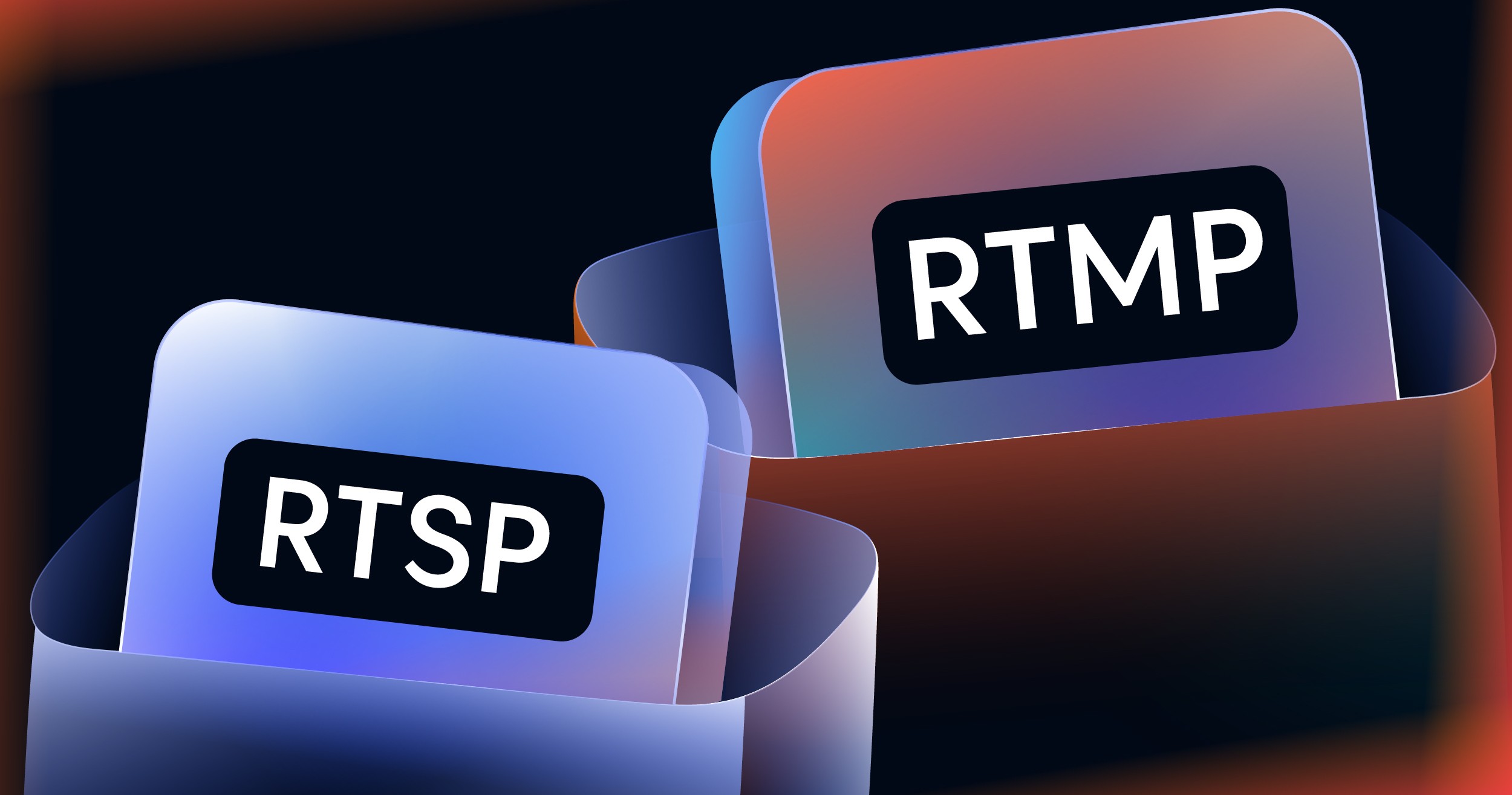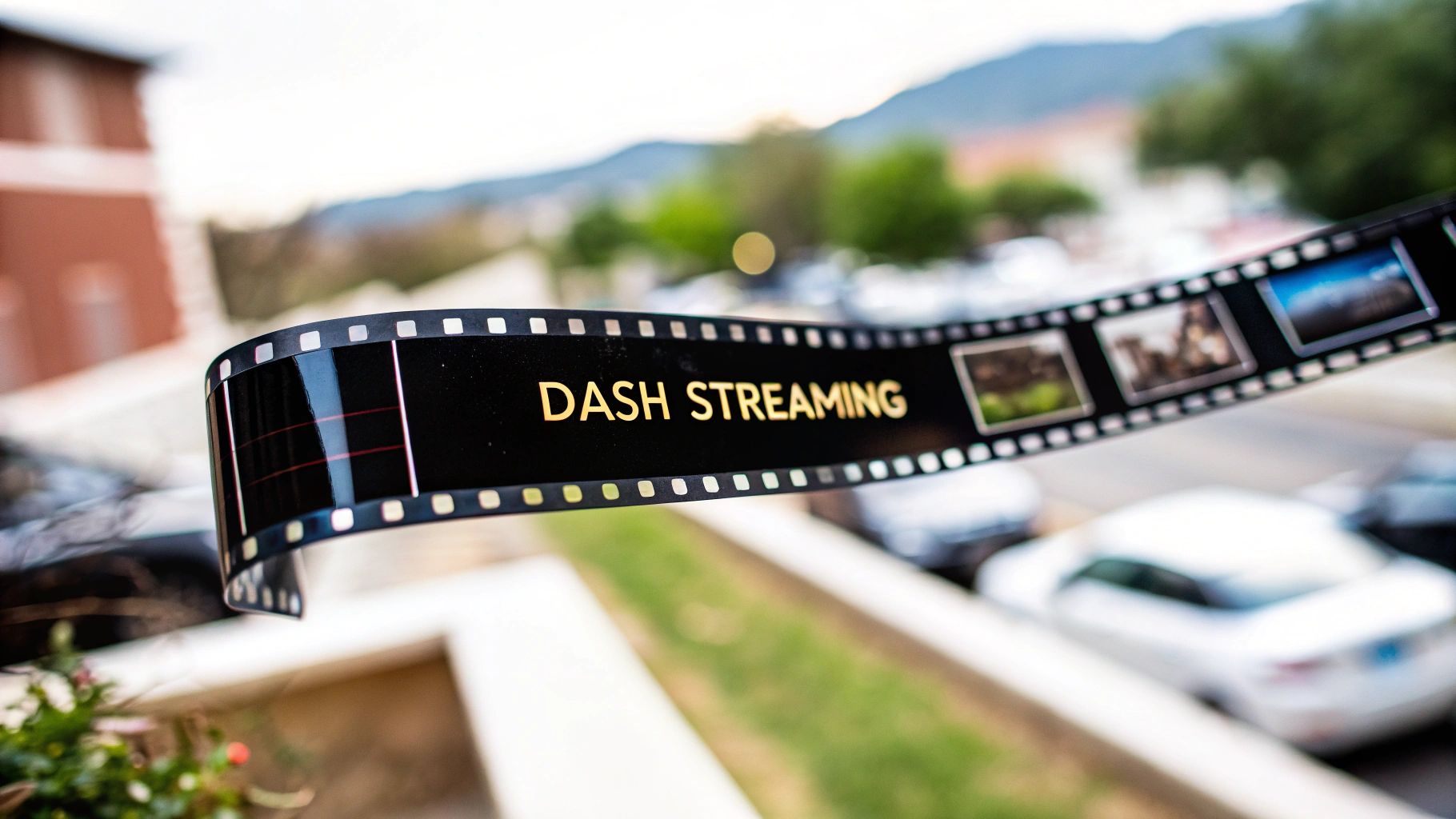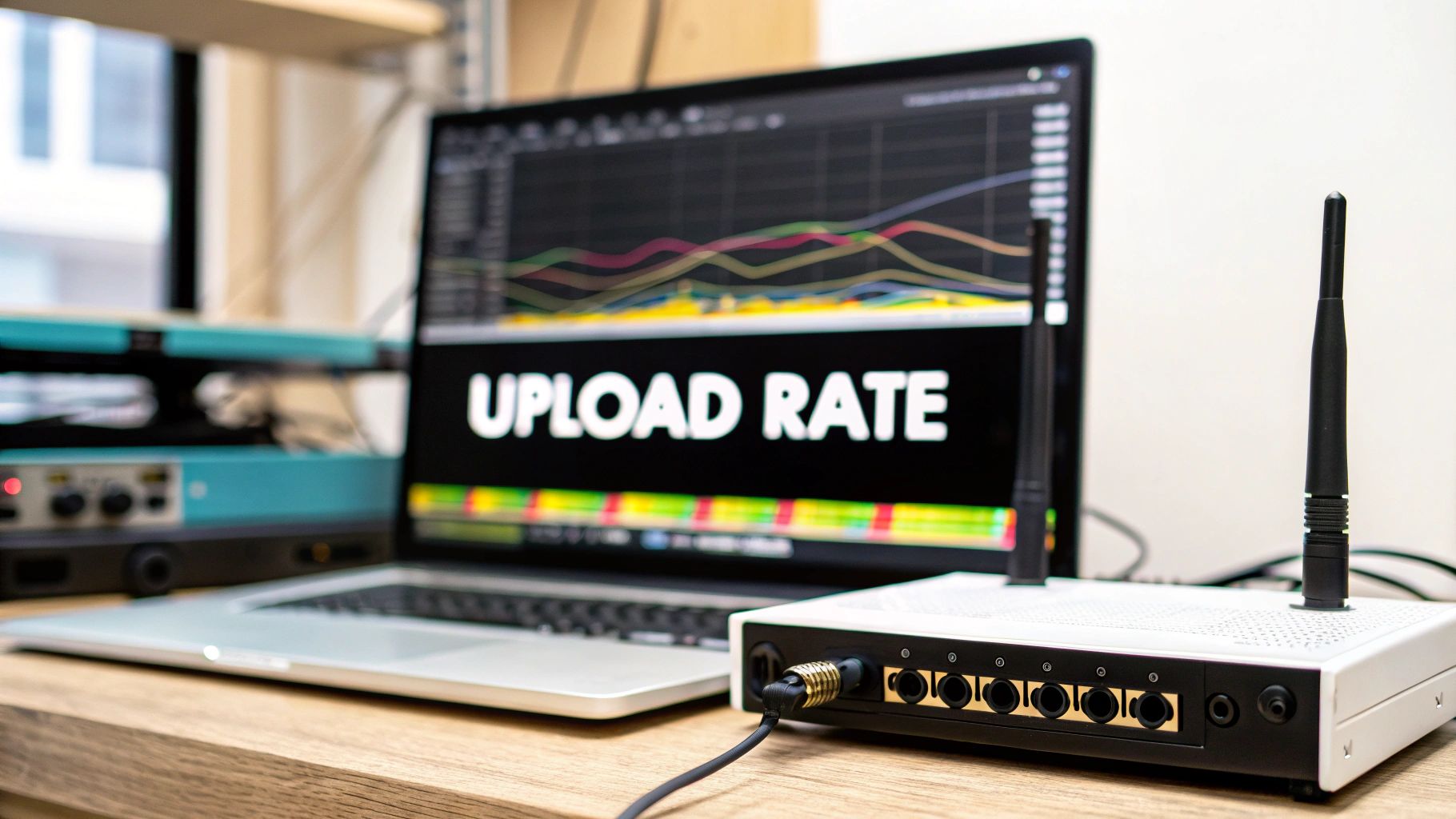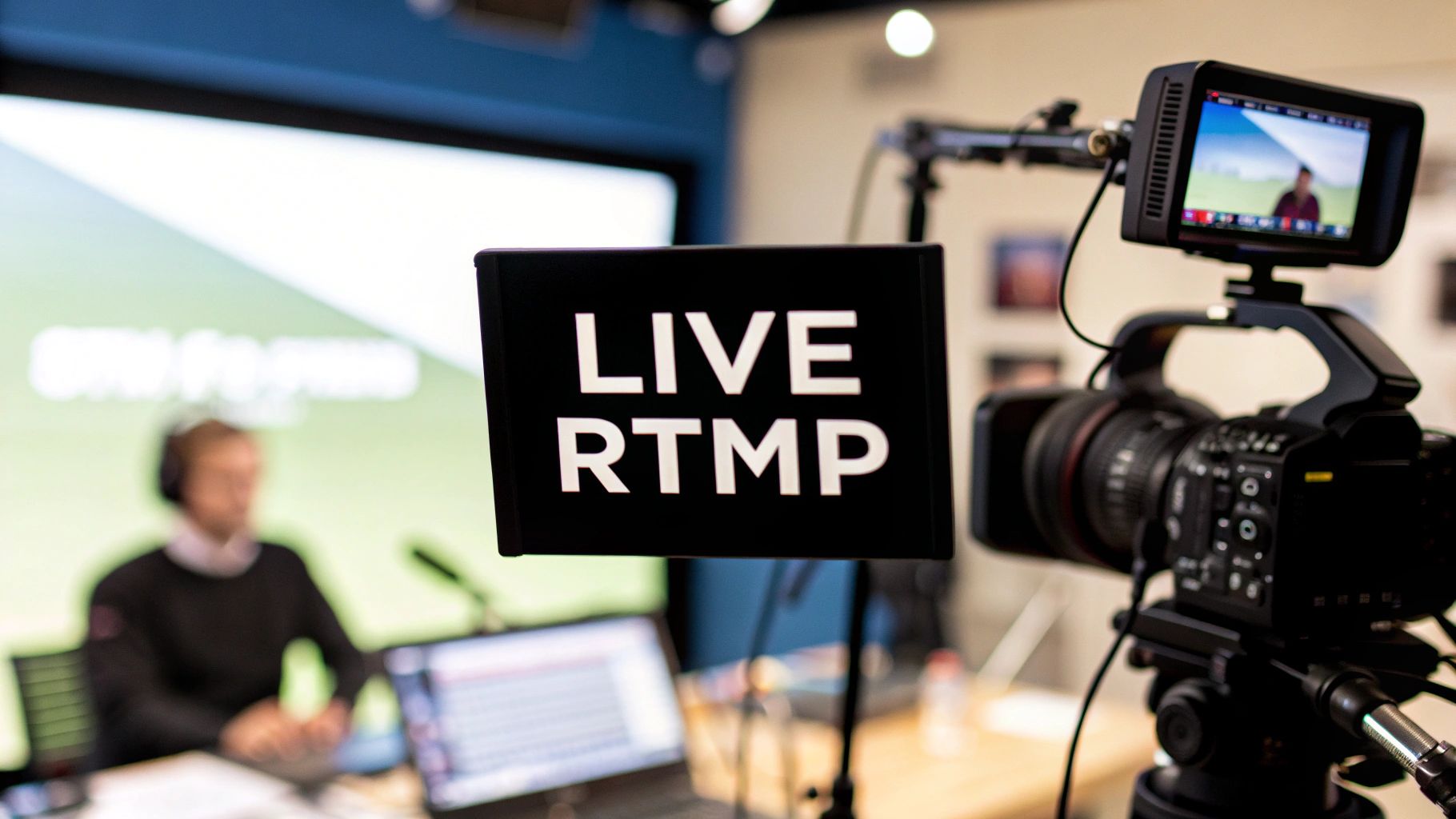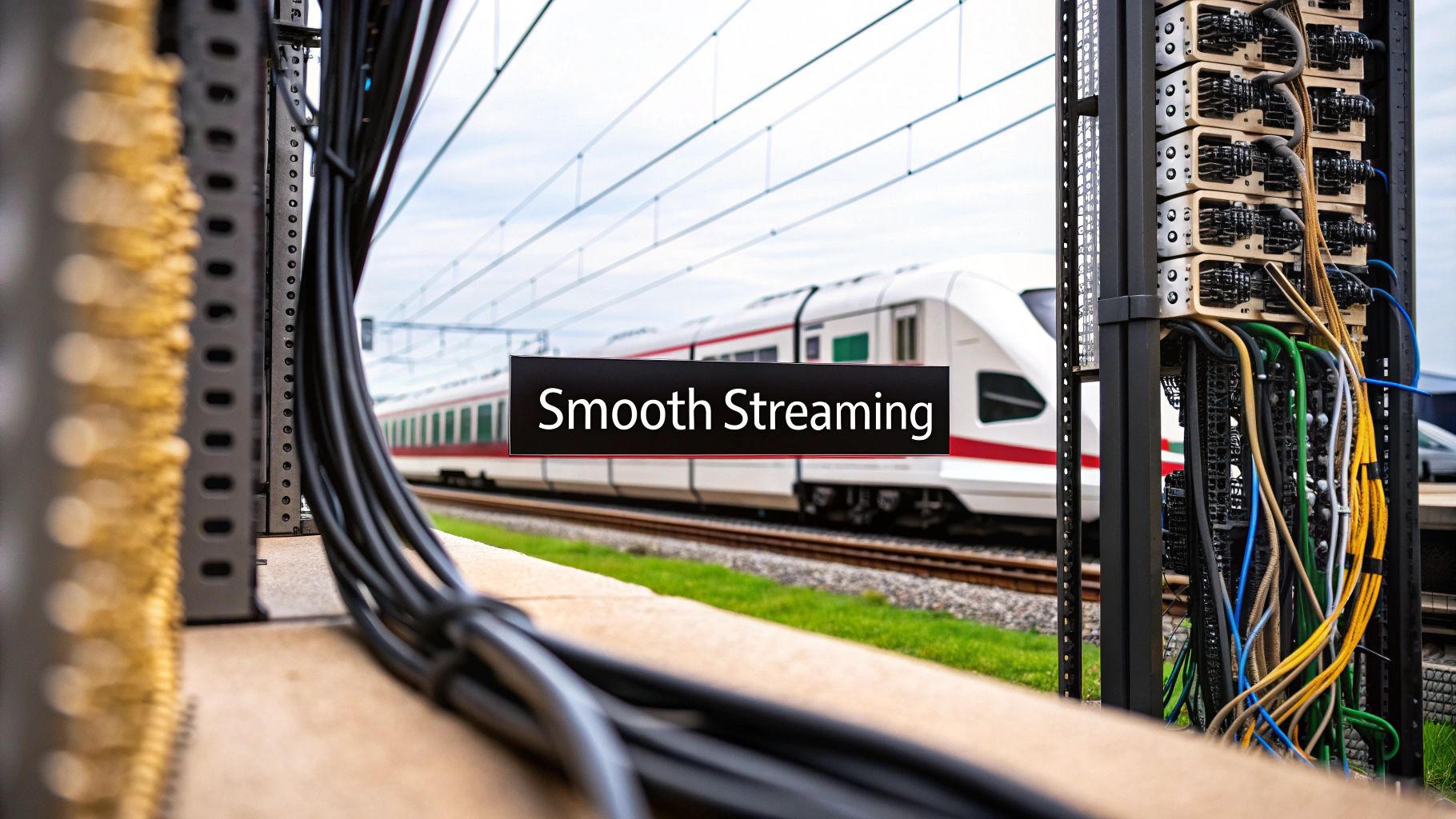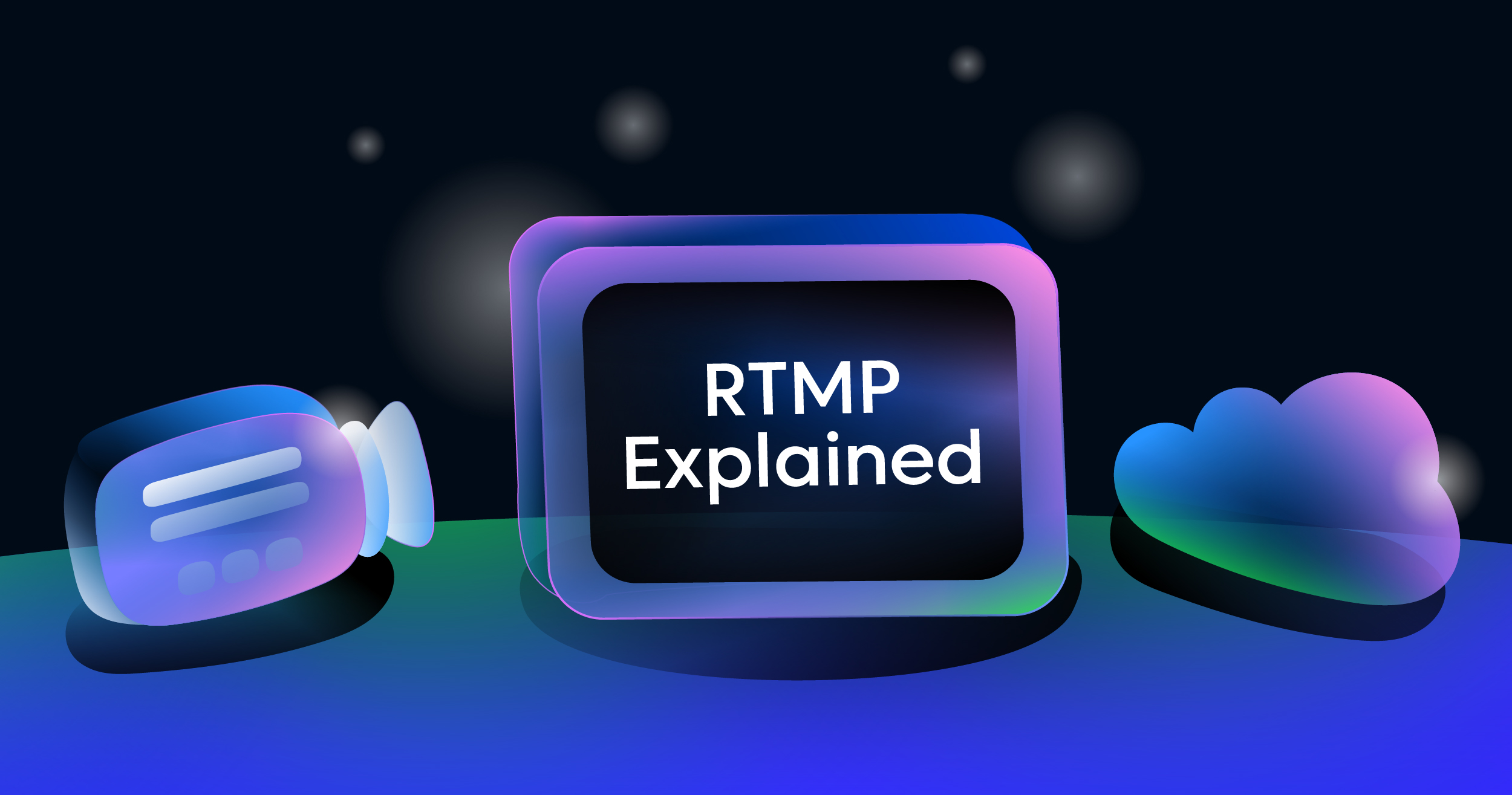Deciding between RTSP and RTMP really boils down to what you’re trying to accomplish. If your goal is to push a live broadcast out to a huge audience with minimal delay, RTMP has long been the go-to standard. But, if you’re working within a closed network and need real-time command and control—think IP security cameras—then RTSP is king. The choice really depends on whether you’re “pushing” content out or “controlling” a media stream from a distance.
RTSP vs RTMP: The Core Differences Explained
The fundamental split between the Real-Time Streaming Protocol (RTSP) and the Real-Time Messaging Protocol (RTMP) comes from their original design goals. RTMP was specifically engineered to send video and audio from an encoder to a server. It’s a classic “push” model, which is why it became perfect for live event broadcasting.
RTSP, on the other hand, operates more like a remote control for a media server. It’s built to issue commands like “play” or “pause,” while a completely separate protocol handles the heavy lifting of delivering the actual data. This architectural difference is why they ended up in such different places—RTMP dominated ingest for platforms like YouTube and Twitch, while RTSP became the backbone for surveillance and private network streaming.
How Do Their Core Attributes Stack Up?
To really make the right call between RTSP and RTMP, you have to get into the technical weeds a bit. One protocol is brilliant at distributing video far and wide through Content Delivery Networks (CDNs), while the other is purpose-built for direct, super-low-latency control over a local network.
To help clear things up, here’s a quick summary table that lays out the key differentiators between these two streaming protocols.
RTSP vs RTMP Quick Comparison
| Attribute | RTSP (Real-Time Streaming Protocol) | RTMP (Real-Time Messaging Protocol) |
|---|---|---|
| Primary Use Case | Command and control for IP cameras, surveillance, and private network streaming. | First-mile ingest for live broadcasting to public platforms and CDNs. |
| Latency | Extremely low (often <1 second) on local networks, making it ideal for real-time monitoring. | Low (typically 2-5 seconds), optimized for reliable ingest over the public internet. |
| Transport Method | Uses TCP for control signals and can use UDP or TCP for media data via RTP. | Relies exclusively on TCP for stable, reliable data transmission. |
| CDN Integration | Not built for CDNs; designed for point-to-point or private network use. | Excellent CDN support, making it the standard for large-scale live events. |
| Codec Support | Flexible; supports a wide range of codecs like H.264, H.265, and AAC. | Traditionally associated with H.264 video and AAC audio codecs. |
This table shows that while both handle real-time video, their strengths are in completely different arenas.
The real takeaway is this: RTMP is the workhorse for delivering content over the public internet, while RTSP is a precision tool for controlling private, real-time video feeds. Picking the wrong one can introduce a world of unnecessary complexity or create performance bottlenecks you just don’t need.
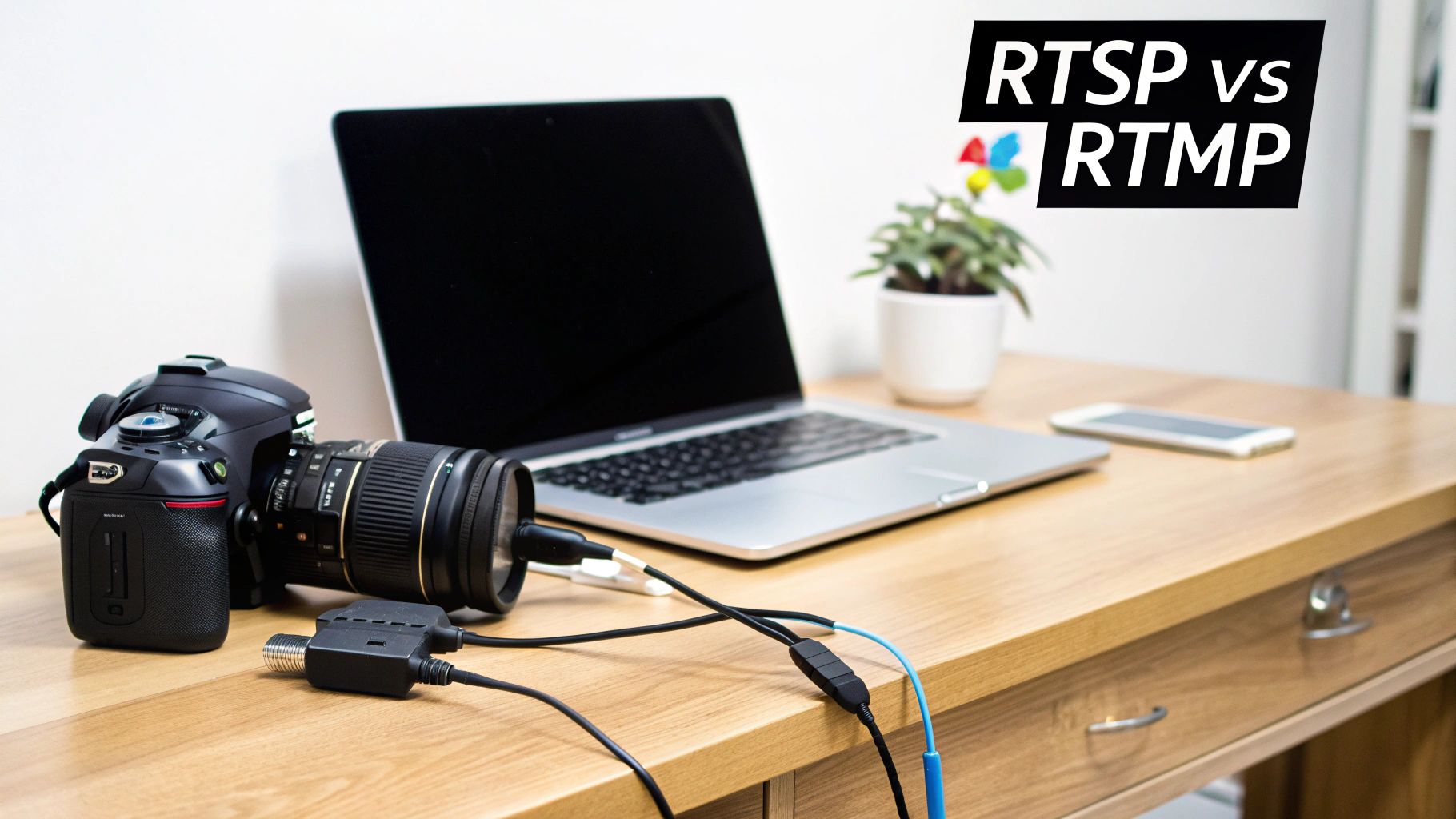
Ultimately, your environment and objective will steer you to the right choice. For a public webinar meant for thousands of viewers, RTMP’s easy integration with services like LiveAPI and its CDN-friendly nature make it the obvious winner. But for managing a fleet of security cameras on-site, the low-latency control offered by RTSP is something you simply can’t compromise on. With this foundation, we can now dig deeper into how each protocol works under the hood.
Understanding the Foundations of RTSP and RTMP
To really get a handle on the RTSP vs. RTMP debate, you have to go back to their roots. Each protocol was built to solve a completely different problem, and those original design choices still shape how we use them today. Their architectures aren’t just technical trivia; they’re the reason one is perfect for broadcast ingest while the other is the go-to for command-and-control.

Understanding this context is everything. Picking the right protocol means matching your project’s goals with the core mission that protocol was designed for in the first place.
The Rise of RTMP for Live Broadcasting
The Real-Time Messaging Protocol, or RTMP, came out of Macromedia back in the early 2000s (later bought by Adobe) for one main reason: to get audio and video to the Adobe Flash Player. Flash was the king of web media back then, and RTMP was the engine making it all happen. It was built for stable, low-latency transmission over TCP, which made it a natural fit for live content.
Even after Flash faded away, RTMP found a new life. Its reliable “push” method for sending media from an encoder to a server made it the perfect ingest protocol for massive streaming platforms. Giants like YouTube, Twitch, and Facebook Live all made RTMP their standard for getting live feeds from creators. You can dive deeper into its modern role in our detailed guide on the RTMP protocol.
This history is why RTMP is still a cornerstone of the streaming world. It’s the first leg of the live streaming journey—that dependable connection between a creator’s gear and a CDN’s global network.
RTSP: The Network Remote Control
On the other hand, the Real-Time Streaming Protocol (RTSP) was never really about pushing data. It was designed as an application-layer protocol to act more like a network remote control for media servers. Think of it like your TV remote: it sends commands like “play,” “pause,” and “record,” but it doesn’t actually deliver the show itself.
RTSP establishes and controls media sessions between endpoints. The actual media data is typically delivered by a separate protocol, most commonly the Real-time Transport Protocol (RTP), which can run over UDP for speed or TCP for reliability.
This command-and-control structure made RTSP the ideal choice for any situation where you need to directly interact with the stream’s source.
- IP Surveillance Cameras: Security staff can use RTSP commands to pan, tilt, and zoom cameras from a control room.
- Industrial IoT: An operator can start or stop a monitoring feed from a piece of factory machinery in real-time.
- Video Conferencing: The system can manage the session state for every person in the call.
At their core, RTMP and RTSP were built for different jobs. RTMP became the standard for getting live streams onto social media and entertainment platforms thanks to its low latency and reliability. RTSP, with its interactive command structure, found its niche in applications like surveillance systems where direct control over the media session is essential. This fundamental difference in purpose is the single most important thing to remember when choosing between them.
A Technical Analysis of Protocol Performance
When you get down to the nuts and bolts of RTSP versus RTMP, you see that their performance differences aren’t accidental. They’re a direct result of how each protocol was designed from the ground up—their transport mechanisms, connection models, and core philosophies. For any developer trying to build a solid streaming application, understanding these technical details is everything.
The biggest fork in the road is the transport protocol. RTMP is built exclusively on the Transmission Control Protocol (TCP). This is a big deal because TCP guarantees that every single data packet gets delivered, in the right order, without any loss. It’s this built-in reliability that made RTMP the undisputed king of live ingest for years.
RTSP, on the other hand, is more of a control protocol. It tells the stream what to do, but the actual media data (sent via RTP) can use either TCP for reliability or the User Datagram Protocol (UDP) for raw speed. This flexibility is its defining feature, making it a chameleon that can adapt to different network conditions and application demands.
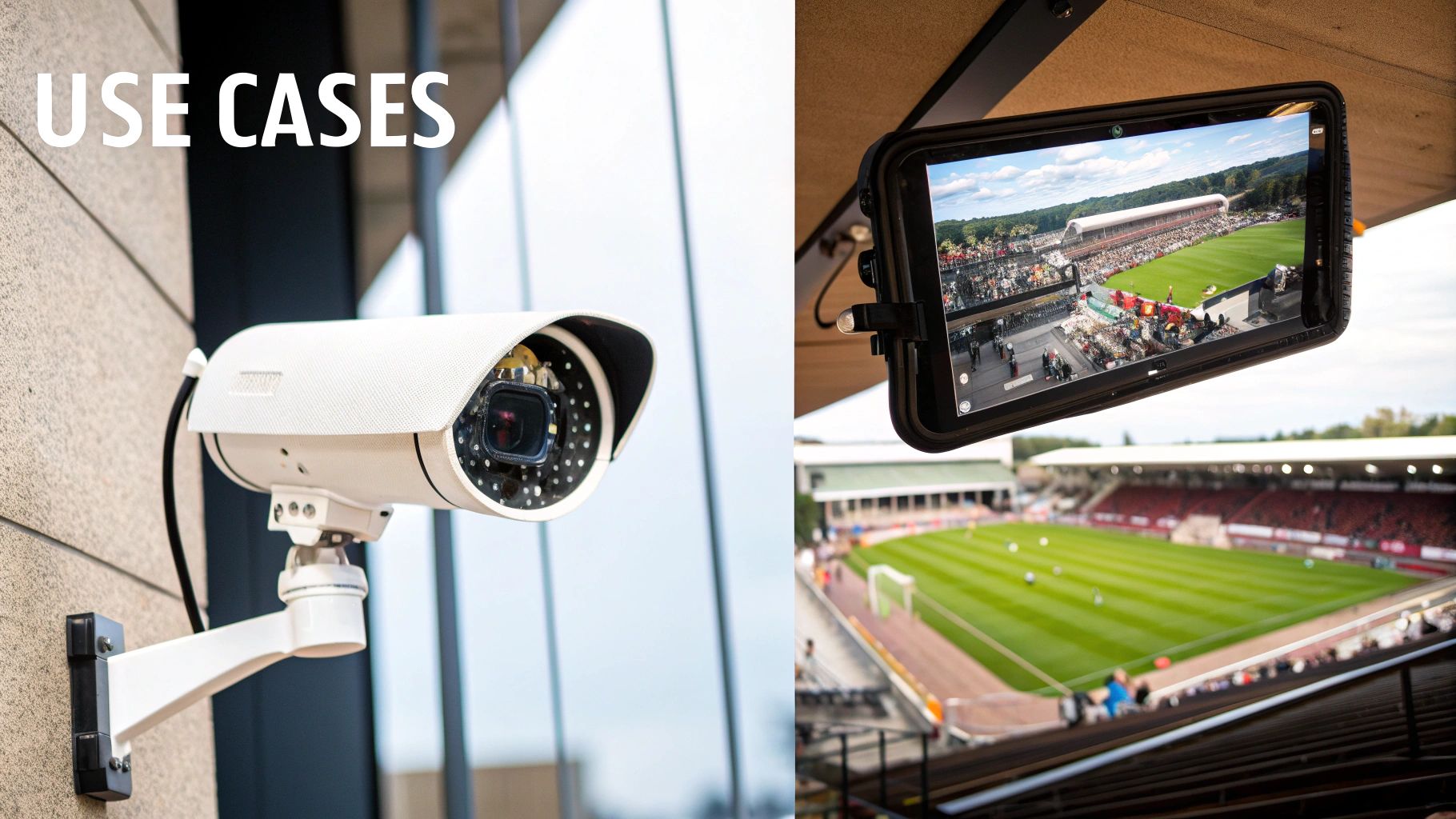
Latency and Connection Management
Latency—the gap between an event happening and a viewer seeing it—is often the metric that matters most. RTMP became famous for its low latency, consistently hitting a sweet spot in the sub-2 to 5-second range over the public internet. It pulls this off by maintaining a persistent, stateful connection between the encoder and the server.
Think of this persistent connection as an open highway for your data. Because the path is always established, you skip the overhead of constantly setting up new connections. RTMP also uses a clever message chunking system that breaks down video and audio into smaller pieces, allowing for a steady, immediate flow of data instead of waiting for huge segments to build up. This is a direct contributor to its low-latency performance.
RTSP’s latency, however, is a classic “it depends” situation. On a stable local network (LAN) running over UDP, RTSP/RTP can achieve mind-bogglingly fast sub-second latency. This is precisely why it dominates the IP camera and surveillance world, where getting the most current frame right now is more important than catching a few lost packets.
But if you configure RTSP/RTP to run over TCP for better reliability or push it over a chaotic network, the latency can climb, sometimes matching or even exceeding RTMP. While RTSP is also stateful, its control channel adds a layer of complexity that gives developers fine-grained control at the potential cost of simplicity.
RTSP’s flexibility is its greatest strength and biggest challenge. The choice between TCP and UDP for media transport creates a direct trade-off: use UDP for ultra-low latency where some packet loss is acceptable (like surveillance), or use TCP for perfect stream integrity at the cost of higher potential delay.
Reliability and Packet Loss Handling
The way these two protocols handle data integrity couldn’t be more different. Since RTMP is welded to TCP, reliability is baked right into its DNA. TCP has built-in mechanisms for error checking, retransmitting lost packets, and controlling data flow. If a packet gets lost in transit, TCP automatically asks for it again, ensuring the server receives a complete, uncorrupted stream.
This makes RTMP incredibly robust for “first-mile” contribution, where the source stream has to be perfect. The catch? On a choppy network, this retransmission process can cause buffering and drive up latency as the system waits for those missing packets to arrive.
RTSP’s reliability is entirely up to how you set it up. When you pair it with RTP over UDP, there’s no built-in system for retransmitting lost packets. This is by design. For applications like a security feed, a single dropped frame is a much better outcome than a stream that’s seconds behind.
But for situations where you need both RTSP’s control and rock-solid reliability, you can run it over TCP. In this mode, it acts a lot more like RTMP, guaranteeing every packet makes it. This configuration is popular when stream integrity is non-negotiable, but it means sacrificing the ultra-low latency you get with UDP.
Codec Compatibility and Bandwidth Efficiency
Technically, both protocols don’t really care what codec you use; they just transport the data. But in the real world, history and common usage have created some standard pairings.
- RTMP: Almost always found with the H.264 video codec and AAC audio codec. This duo offered a fantastic balance of quality and compression, which helped it become the standard for major streaming platforms.
- RTSP: Supports a much wider, more modern array of codecs, including H.264, H.265 (HEVC), MJPEG, and MPEG-4. Its native support for newer, highly efficient codecs like H.265 gives it a serious edge for 4K streaming and in any scenario where bandwidth is tight.
Bandwidth efficiency is directly tied to codec support. Because RTSP can use H.265, it can deliver video of the same quality as H.264 using about half the bitrate. That’s a massive win for high-resolution streaming. While it’s possible to shoehorn newer codecs into RTMP, its entire ecosystem is built around H.264. To get better efficiency from an RTMP ingest, broadcasters usually transcode the stream on the server and use techniques like adaptive bitrate streaming to deliver the best possible quality to each viewer based on their connection.
How Industry Trends Shape Protocol Adoption
The choice between RTSP and RTMP isn’t just a technical debate—it’s driven by major shifts in the market. While RTMP became the go-to for live ingest thanks to social media and content creators, RTSP has secured a vital role in industries where instant control is everything. Getting a handle on these market forces is the key to picking a protocol that will last.
You would think the death of Adobe Flash would have been the end for RTMP, but the opposite happened. Its low-latency and rock-solid ingest capabilities were just too good to throw away. The industry simply adapted, cementing RTMP’s place as the perfect “first-mile” solution for getting a stream from an encoder to a media server. After that, modern protocols take over for delivery to the masses, a process we break down in our guide to HTTP Live Streaming.
The Surge in RTSP for Surveillance and IoT
While RTMP cornered the market on public broadcasting, RTSP’s momentum comes from the explosion of connected devices. The Real-Time Streaming Protocol is seeing huge growth, mainly because of its deep integration into IP surveillance and the Internet of Things (IoT). Market forecasts show RTSP expanding at a compound annual growth rate (CAGR) of about 9.7%. Projections estimate the market could hit around USD 3.25 billion by 2033. This isn’t surprising when you consider the global investment in smart security and industrial monitoring, where low-latency video command and control are absolutely essential.
This all points to a clear split in the market:
- RTSP’s Domain: Its growth is directly tied to smart cities, automated factories, and home security. In these use cases, the ability to send a “pan/tilt/zoom” command and see it happen instantly isn’t a feature—it’s a requirement.
- RTMP’s Enduring Relevance: It’s still the workhorse for creators and broadcasters. Their main goal is to push a high-quality, stable feed to a CDN for a worldwide audience, and RTMP does that better than anything else.
The market isn’t crowning a single winner; it’s creating specialists. RTSP is expanding by owning the machine-to-machine and real-time monitoring world, while RTMP holds its ground as the most reliable on-ramp to the global streaming superhighway.
How Market Demands Influence Your Choice
So, when you’re choosing a protocol, you’re really aligning your project with these big-picture industry trends.
Let’s say you’re building an application for a commercial security firm to manage hundreds of IP cameras on a private network. The market trends point you straight to RTSP. Its entire ecosystem, from the hardware to the low-latency control features, is built for exactly that job.
On the other hand, if you’re building a platform for broadcasting live events, the industry standard for ingest is still RTMP. It has massive support across encoders and media servers like LiveAPI, guaranteeing a smooth, scalable workflow designed to reach huge audiences. The market has already built the infrastructure around this model, making it the most practical choice for public-facing content. Your decision in the RTSP vs RTMP showdown should be based not just on tech specs, but on the powerful, market-tested ecosystems that have grown up around each protocol.
Practical Use Cases: Where RTSP and RTMP Shine
Knowing the specs is one thing, but figuring out which protocol to actually use for your project is another. The truth is, a protocol that’s perfect for one job can be a total disaster for another. Let’s move past the theory and look at real-world situations where the choice between RTSP and RTMP becomes crystal clear.
It often comes down to one key question: Are you pushing a one-way broadcast out to a huge audience, or do you need hands-on, interactive control over a camera within a closed network? Your answer will almost always lead you straight to either RTMP or RTSP.
When to Choose RTMP
The Real-Time Messaging Protocol is still the undisputed king of the “first mile” in live broadcasting. It’s all about getting your stream from your encoder to your media server or CDN reliably. Its rock-solid performance and universal support make it the default for almost any public-facing stream.
1. Live Event Broadcasting
If you’re streaming a concert, conference, webinar, or church service to the public, RTMP is your workhorse. It runs on TCP, which means it works tirelessly to ensure every single packet of video and audio data arrives in one piece. This is non-negotiable for maintaining a professional, buffer-free broadcast quality. Every major CDN is built to take in an RTMP stream before repackaging it into formats like HLS for delivery to viewers everywhere.
The Bottom Line: Pick RTMP for its bulletproof CDN support and reliability for ingest. Its job is to push a stable, high-quality stream to a server, making it ideal for one-to-many broadcasts where stream integrity trumps the need for sub-second latency.
2. Social Media Streaming
Headed for YouTube Live, Facebook Live, or Twitch? The decision is already made. These giants built their entire live video infrastructure on RTMP ingest. Almost every piece of streaming software you can think of, from the free and powerful OBS Studio to pro-level tools like vMix, is fine-tuned to send RTMP.
3. Online Gaming and Esports
While newer protocols like WebRTC are making inroads for direct player-to-player chat, RTMP remains a cornerstone for streaming gameplay to platforms like Twitch. Its low-latency ingest means a streamer’s actions are shown to their audience with very little delay, which is absolutely critical for keeping the chat engaged and the interaction feeling live.
When to Choose RTSP
The Real-Time Streaming Protocol really comes into its own in closed-off environments where you need direct control and the lowest possible latency. It was fundamentally designed for command-and-control applications, not for broadcasting to the masses.
1. IP Security Cameras and Surveillance
This is the classic, textbook use case for RTSP. A security system needs to do more than just show a video; it needs to respond to commands like pan, tilt, zoom, play, and pause—and show the results instantly. Because it typically runs over UDP on a local network, RTSP can hit that sub-second latency mark, giving operators the immediate visual feedback they need to do their jobs effectively.
This diagram shows how RTSP creates that direct control loop by separating the command signals from the actual media stream.
This unique architecture is precisely what makes RTSP so powerful for surveillance. It lets an operator interact with a camera in real time, without the frustrating delays you’d get from a broadcast-focused protocol.
The Bottom Line: Go with RTSP when you need direct, low-latency control over a camera on a private network. It was built to be a network “remote control,” making it a perfect fit for any application where interacting with the camera is just as important as watching the feed.
2. In-House Video Conferencing Systems
In a corporate boardroom or a university lecture hall, RTSP can be used to manage the video feeds within a dedicated conferencing system. It gives a central server the power to start, stop, and direct video from multiple participants, keeping the session running smoothly. While WebRTC has taken over for browser-based calls, many hardware-based systems still rely on RTSP under the hood.
3. Remote Industrial Monitoring
Picture an operator in a control room who needs to watch a critical piece of machinery on a factory floor. RTSP lets that operator not only view the live feed but also take control of the camera to inspect different parts of the machine up close. In this RTSP vs RTMP scenario, the protocol’s minimal delay is essential for making quick, informed decisions based on what’s happening hundreds of feet away.
How to Pick the Right Protocol: A Practical Decision Framework
Choosing between RTSP and RTMP isn’t just a technical detail—it’s a foundational decision that impacts your entire streaming workflow. To cut through the noise in the RTSP vs RTMP debate, let’s frame the choice around what you’re actually trying to build. Your answers to a few straightforward questions will point you in the right direction.
Key Questions to Guide Your Choice
Start here. Before you write a single line of code, get clear on your core objectives.
- Is my primary goal one-way broadcasting or interactive, two-way camera control? If you’re simply pushing a video stream out to a CDN or a social media platform, RTMP is the industry workhorse. But if you need to send commands back to the camera—think pan, tilt, and zoom functions—RTSP was literally designed for that kind of interaction.
- What’s my real-world tolerance for latency? For applications like security monitoring on a private network where seeing things in near real-time is non-negotiable, RTSP’s sub-second latency is a huge advantage. If you’re broadcasting to a large public audience where a delay of a few seconds is perfectly acceptable for the sake of stream stability and scale, RTMP is the more practical and reliable option.
- How critical is broad, out-of-the-box CDN support? This is a big one. RTMP is the de facto standard for ingest across virtually every major CDN and live streaming platform, including services like LiveAPI. If your goal is to scale quickly and reach the widest possible audience, choosing RTMP saves you a ton of headaches.
This decision tree breaks down how your project’s specific needs for latency, bandwidth, and security map directly to a protocol choice.
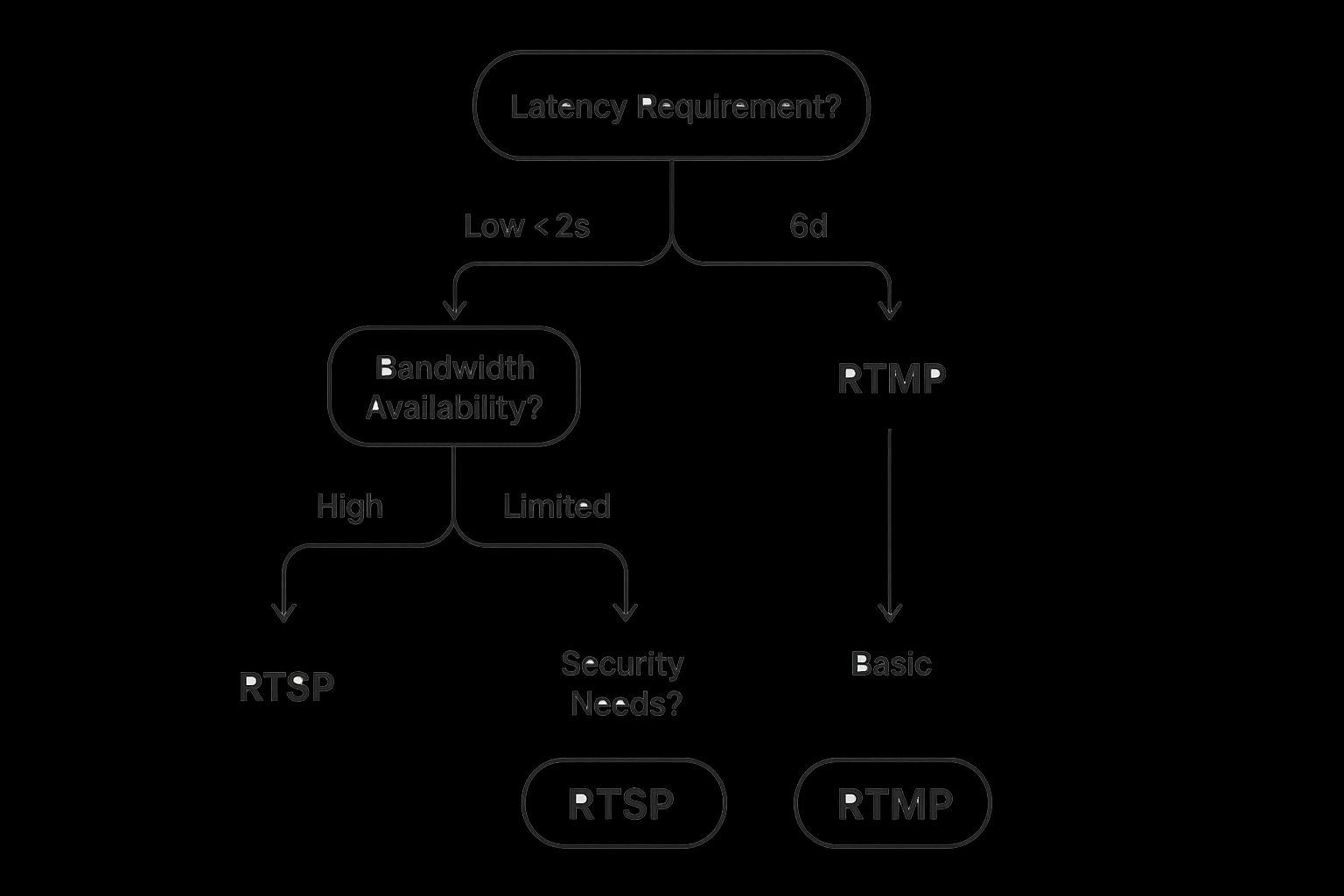
As the visual guide shows, your technical constraints are the best compass for navigating this choice. It’s a decision developers are making more often, fueling a streaming media processor market valued at USD 8.2 billion in 2024 and projected to hit USD 21.5 billion by 2033. The growth is undeniable, and you can dig deeper into the market trends driving it with industry analysis from Verified Market Reports.
Answering Your Top RTSP vs. RTMP Questions
When you get down to the nitty-gritty of choosing between RTSP and RTMP, some common questions always pop up. Let’s tackle them head-on, moving past the basic specs to address how these protocols actually behave in the real world.
Can I Use RTSP for Internet Broadcasting Like I Would with RTMP?
You technically can, but you really shouldn’t. Using RTSP for large-scale internet broadcasting is like trying to drive a forklift on the highway—it’s just not the right tool for the job.
RTSP was built for controlling streams on closed, local networks. It hits a wall with common internet hurdles like firewalls and isn’t supported by web browsers. This means your audience would have to download special software, like VLC Media Player, just to watch.
RTMP, on the other hand, was designed specifically for this. It plays nicely with virtually every CDN and media server out there, making it the go-to for ingesting live video meant for a public audience.
Is RTMP Dead Now That Flash Is Gone?
Not at all. RTMP’s role has just shifted. While the end of Adobe Flash Player meant the end of RTMP for browser-based playback, it’s still the undisputed king of ingest.
Think of it as the “first mile” of your stream’s journey. Encoders send a stable, low-latency RTMP feed to a media server. That’s why major platforms like YouTube Live and Twitch still depend on it for receiving streams from creators.
RTMP didn’t die; it just got a promotion. It moved from being a playback protocol to the industry-standard ingest protocol. Media servers handle the handoff, taking in the reliable RTMP stream and repackaging it into modern formats like HLS for delivery to viewers everywhere.
What’s the Real Difference in Security?
The security models for RTSP and RTMP are shaped by where they’re typically used. Getting this right is critical for protecting your content.
- RTMP Security: The solution here is straightforward: RTMPS. This protocol simply wraps the RTMP data in a secure SSL/TLS connection. It’s the standard for a reason—it’s widely supported by CDNs and streaming platforms, making it easy to encrypt your public broadcasts.
- RTSP Security: Because RTSP usually lives on private networks (think security cameras), protection often relies on network-level defenses like firewalls and VPNs. Secure versions of RTSP exist, but they aren’t as standardized as RTMPS and often require custom setups.
It really boils down to your environment. RTMPS gives you a plug-and-play encryption method perfect for streams traveling over the public internet. RTSP’s security is more about locking down the network it’s on, which is a perfect fit for its role in private surveillance and industrial IoT.
Ready to build your streaming application on a reliable, scalable, and developer-friendly platform? LiveAPI cuts through the complexity of video streaming with robust RTMP ingest, instant transcoding, and global delivery. Start building with LiveAPI today and get your video features to market faster.
